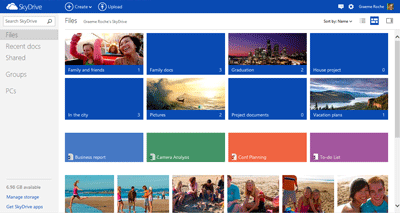News
SkyDrive Gets 'Modern' UI, Exits Beta
- By Kurt Mackie
- August 16, 2012
Microsoft's SkyDrive cloud storage solution for consumers has left the preview stage, the company announced this week.
As of Wednesday, users were receiving new SkyDrive updates, which include a "Metro" or "modern" user interface (or whatever term Microsoft may settle on to describe its flat, tile-like menu display). SkyDrive, which is made available to users via Microsoft's Internet cloud, generally provides 7 GB of free storage, down from the previous 25 GB that earlier SkyDrive users received. Microsoft offers a pricing tier for extra storage, ranging from 20 GB at $10 per year to 100 GB at $50 per year.

[Click on image for larger view.] |
Microsoft announced previews of SkyDrive for Windows and SkyDrive for OS X Lion back in April. There also are apps for SkyDrive that were announced in December, including SkyDrive Apps for iPhone, iPad and touch-based iPod, plus a SkyDrive App for Windows Phone.
SkyDrive for Windows and SkyDrive for OS X Lion have capabilities that are different from the SkyDrive apps, which run in browsers. For instance, there's a notable difference in terms of file-size handling limits. Uploads using SkyDrive for Windows and SkyDrive for Mac OS X Lion are limited to 2 GB, whereas the browser-based SkyDrive apps have a 300-MB upload limit. Microsoft provided the following rationale to explain this difference.
"Many cloud services place different limits on file upload size, depending on whether the customer is using a desktop application or the browser, as larger file uploads require a more advanced upload behavior," a Microsoft spokesperson clarified by e-mail. "SkyDrive customers can upload files up to 300 MB in size in the browser and up to 2 GB using SkyDrive for the Windows Desktop (preview) and SkyDrive for Mac OS X Lion (preview)."
New SkyDrive Perks
Microsoft announced a new SkyDrive for Android App on Tuesday that works in a browser running on an Android-based smartphone. However, unlike the other SkyDrive apps, which need to be downloaded and installed on mobile devices, the SkyDrive for Android App can be accessed by using a Web browser on the device to access SkyDrive.com, according to Microsoft's SkyDrive download page.
Despite that claim, the SkyDrive for Android App also will be available as a download. A Microsoft Twitter post on Tuesday stated that it "will be in the Google Play Store in just a few weeks."
Microsoft added a few new perks for developers working with SkyDrive APIs. They can add a SkyDrive file picker by adding JavaScript code to a Web site, enabling the opening and saving of files to SkyDrive. Also, file-type restrictions for uploads were removed, and images now can be uploaded in full resolution, according to Microsoft's announcement.
SkyDrive users get a few new perks with the upgrade. There's a new search capability to find Office documents stored in the cloud, as well as a "contextual toolbar" at the top of the screen for easier access to commands. Microsoft added the ability to select multiple files in the thumbnail view for rearranging photos. It's also now possible to drag and drop files and folders. Photos now can be sorted by date. Photos will upload 1.7 times faster with the new update, according to Microsoft.
Microsoft still provides just one folder for synchronizing changes between SkyDrive storage and devices. Its engineering team is currently working on a future solution that will enable users to specify which SkyDrive folders they want to synch.
Microsoft has yet another consumer cloud storage system called Windows Live Mesh. It's similar to SkyDrive but has greater sync controls. Microsoft may be trying to eliminate Windows Live Mesh by attrition. For instance, veteran Microsoft reporter Mary Jo Foley has noted that a new Windows Essentials 2012 update will switch Windows Live Mesh users over to SkyDrive.
SkyDrive Pro
Microsoft has developed still another cloud storage service called "SkyDrive Pro," which is designed for businesses and organizations, rather than consumers. SkyDrive Pro works with SharePoint 2013, both hosted and on premises versions. It will leverage some SharePoint capabilities, such as "social networking, collaboration, search, metadata, workflow and compliance," according to Jeff Teper, corporate vice president of SharePoint, in a July announcement.
Exactly when SkyDrive Pro will be available hasn't been announced. SharePoint 2013 is unofficially anticipated for release in the fourth quarter of this year.
About the Author
Kurt Mackie is senior news producer for 1105 Media's Converge360 group.